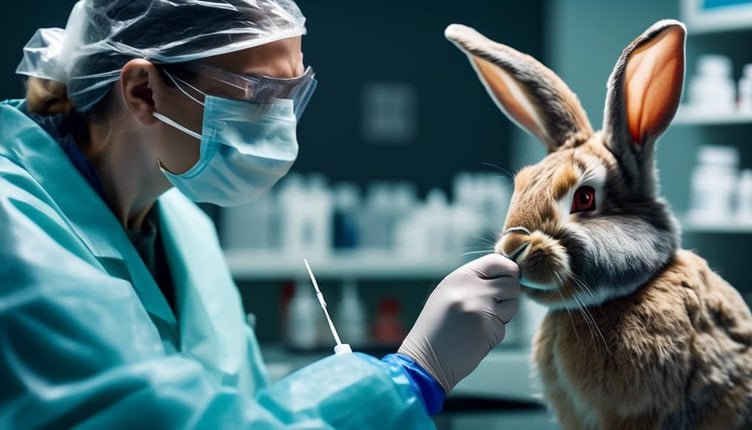Understanding the symptoms and management of Pasteurellosis in rabbits is absolutely crucial for any rabbit owner or enthusiast. This highly contagious bacterial infection can cause a myriad of health issues in rabbits, ranging from pesky respiratory problems to downright terrifying abscesses and even death. It is imperative to identify the symptoms early on, as this will enable swift and effective treatment, thereby preventing further spread of this insidious disease.
By implementing proper management strategies, such as regular veterinary check-ups, appropriate hygiene practices, and targeted treatment options, rabbit owners can minimize the impact of Pasteurellosis and ensure the health and well-being of their beloved furry companions.
But what are the telltale symptoms to keep an eagle eye out for, and how can this nefarious disease be effectively managed?
Key Takeaways
- Pasteurellosis is a highly contagious bacterial infection in rabbits, commonly affecting their respiratory system.
- Prompt veterinary care and treatment are necessary to prevent the spread of infection and alleviate the rabbit's suffering.
- Diagnostic tests such as bacterial culture, serological tests, PCR, and histopathological examination can help in identifying Pasteurellosis.
- Prevention and management of Pasteurellosis involve quarantine, good hygiene practices, controlling vectors, and implementing preventive measures.
Understanding Pasteurellosis in Rabbits
Understanding Pasteurellosis in rabbits is crucial for rabbit owners and veterinarians in order to effectively prevent, diagnose, and treat this highly contagious and potentially life-threatening bacterial infection. Pasteurellosis, also known as snuffles, is caused by the bacterium Pasteurella multocida. It's one of the most common respiratory diseases in rabbits and can lead to severe respiratory distress, abscess formation, and even death if left untreated.
Transmission of Pasteurella multocida can occur through direct contact with infected rabbits or through contaminated environments. This bacterium can survive for extended periods in the environment, making it important to maintain proper hygiene and sanitation to prevent its spread. It can also be transmitted through aerosol droplets, making it highly contagious among rabbits in close proximity to each other.
Vaccination plays a crucial role in preventing Pasteurellosis in rabbits. The most commonly used vaccine is the intranasal vaccine, which stimulates mucosal immunity in the respiratory tract. This vaccine helps reduce the severity of clinical signs and decrease the shedding of the bacterium, thus decreasing the risk of transmission.
Common Symptoms of Pasteurellosis
Common symptoms of Pasteurellosis in rabbits include:
- Respiratory signs such as sneezing, nasal discharge, and difficulty breathing.
- Other clinical signs may include abscesses, conjunctivitis, and ear infections.
Treatment options for Pasteurellosis in rabbits include:
- Antibiotics
- Supportive care
- Management practices to reduce stress and prevent the spread of the disease.
Clinical Signs
Clinical signs of Pasteurellosis in rabbits can include respiratory symptoms, ocular discharge, and abscess formation.
Respiratory symptoms may include sneezing, coughing, and nasal discharge. The affected rabbits may also exhibit difficulty breathing, wheezing, and a decreased appetite.
Ocular discharge, commonly referred to as 'snuffles,' can vary in color and consistency, ranging from clear and watery to thick and purulent. This discharge may cause the rabbit's eyes to appear swollen and irritated.
In some cases, Pasteurella infections can lead to the formation of abscesses, which are localized pockets of pus that can occur in various parts of the rabbit's body. These abscesses can cause swelling, pain, and discomfort.
It's important to monitor rabbits for these clinical signs and seek veterinary care promptly to prevent the spread of infection and alleviate the rabbit's suffering.
Treatment Options
After identifying the clinical signs of Pasteurellosis in rabbits, the next step is to explore the available treatment options for the common symptoms associated with this bacterial infection. It's important to manage antibiotic resistance and consider alternative therapies in order to provide effective and sustainable treatment for rabbits suffering from Pasteurellosis.
Here are three treatment options to consider:
- Antibiotic therapy: Antibiotics such as enrofloxacin or chloramphenicol are commonly prescribed to combat the bacterial infection. However, it's crucial to use antibiotics judiciously to prevent the development of antibiotic resistance.
- Supportive care: Providing supportive care is essential to help rabbits cope with the symptoms of Pasteurellosis. This may include providing a clean and comfortable environment, ensuring proper nutrition, and administering pain relief medication if necessary.
- Alternative therapies: In addition to antibiotics, alternative therapies such as herbal remedies, probiotics, and immunostimulants may be considered to enhance the overall immune response and aid in the recovery of rabbits with Pasteurellosis.
Diagnostic Tests for Pasteurellosis

Diagnostic tests play a crucial role in identifying and confirming the presence of Pasteurellosis in rabbits. Test accuracy is of utmost importance to ensure accurate diagnosis and appropriate treatment.
Various diagnostic methods, such as bacterial culture, serological tests, and polymerase chain reaction (PCR), can be utilized to detect the presence of Pasteurellosis.
It's essential for veterinary professionals to carefully interpret the results of these tests to make informed decisions regarding the health and treatment of rabbits affected by Pasteurellosis.
Test Accuracy
The accuracy of diagnostic tests for Pasteurellosis can be determined through rigorous scientific evaluation and evidence-based analysis. It's crucial to ensure that the tests used to diagnose Pasteurellosis in rabbits are highly effective and reliable. Here are three key factors to consider when evaluating the accuracy of these tests:
- Sensitivity: This refers to the ability of the test to correctly identify rabbits that are infected with Pasteurella bacteria. A highly sensitive test will minimize the occurrence of false-negative results.
- Specificity: This measures the ability of the test to accurately identify rabbits that aren't infected with Pasteurella bacteria. A highly specific test will minimize the occurrence of false-positive results.
- Comparative analysis: It's essential to compare the accuracy of different diagnostic tests to identify the most effective option. This can involve evaluating the sensitivity, specificity, and overall diagnostic performance of each test.
Diagnostic Methods
To accurately diagnose Pasteurellosis in rabbits, various diagnostic methods can be employed.
These methods include:
- Bacterial culture: Considered the gold standard for diagnosis, bacterial culture allows for the isolation and identification of Pasteurella species from clinical samples.
- Polymerase chain reaction (PCR): PCR is a molecular technique that can detect the presence of Pasteurella DNA in samples, providing a rapid and sensitive diagnosis.
- Serological tests: Serological tests, such as enzyme-linked immunosorbent assay (ELISA), can detect antibodies against Pasteurella in the rabbit's blood.
- Histopathological examination: Histopathological examination involves the analysis of tissue samples under a microscope, which can reveal characteristic lesions caused by Pasteurella infection.
It's important to note that antibiotic resistance is becoming a concern in Pasteurella infections, making it essential to perform susceptibility testing to guide appropriate treatment.
Understanding the epidemiology and transmission of Pasteurella is crucial for implementing preventive measures and controlling the spread of the disease.
Results Interpretation
After employing the various diagnostic methods for Pasteurellosis in rabbits, the next step is to interpret the results obtained from these tests. Proper analysis of the results is crucial in determining the appropriate treatment and management plan for affected rabbits.
Here are three key points to consider when interpreting the results:
- Identification of Pasteurella multocida: The presence of this bacterium in the samples confirms the diagnosis of Pasteurellosis.
- Antibiotic susceptibility testing: Determining the sensitivity of the isolated strain to different antibiotics helps in selecting the most effective treatment option.
- Treatment effectiveness: Monitoring the response to treatment is essential in evaluating its effectiveness. Regular retesting may be necessary to assess the progress and adjust the treatment plan accordingly.
Accurate results analysis allows veterinarians to make informed decisions and provide optimal care for rabbits affected by Pasteurellosis.
Treatment Options for Pasteurellosis

Treatment options for Pasteurellosis include a variety of antibiotics and supportive care measures. The primary goal of treatment is to eliminate the bacteria causing the infection and alleviate the symptoms in affected rabbits. Antibiotics such as enrofloxacin, ciprofloxacin, and chloramphenicol have shown effectiveness in treating Pasteurellosis in rabbits. These antibiotics inhibit the growth of the bacteria, reduce inflammation, and improve the overall condition of the infected rabbit.
In addition to antibiotics, supportive care measures can help manage the symptoms and promote recovery. This includes providing a clean and comfortable environment for the rabbit, ensuring proper nutrition and hydration, and maintaining good hygiene practices. Regular cleaning of the rabbit's cage and bedding is essential to minimize the spread of the bacteria.
Alternative therapies, such as herbal remedies and homeopathic treatments, have been explored as adjunctive options for Pasteurellosis. However, the effectiveness of these alternative therapies is not well-established and more research is needed to determine their efficacy.
Table: Antibiotics used in the treatment of Pasteurellosis in rabbits
| Antibiotic | Treatment Effectiveness |
|---|---|
| Enrofloxacin | High |
| Ciprofloxacin | Moderate |
| Chloramphenicol | Moderate |
| Amoxicillin | Low |
It is important to consult a veterinarian for proper diagnosis and treatment of Pasteurellosis in rabbits. They can provide guidance on the most appropriate antibiotic and supportive care measures based on the individual rabbit's condition.
Preventing the Spread of Pasteurellosis
Prevention of the spread of Pasteurellosis in rabbits involves implementing strict biosecurity measures to minimize the transmission of the bacteria. This is crucial in order to protect the health and well-being of the rabbits and to prevent the disease from spreading to other animals.
Here are three key measures that can be taken to prevent transmission:
- Quarantine: When introducing new rabbits into an existing population, it's essential to isolate them for a period of time. This allows for observation and testing for any signs of infection before they're introduced to the rest of the rabbits.
- Hygiene Practices: Maintaining good hygiene is vital to prevent the spread of Pasteurellosis. This includes regular cleaning and disinfection of cages, equipment, and any shared spaces. It's also important to wash hands thoroughly before and after handling rabbits.
- Control of Vectors: Effective control of vectors, such as fleas, ticks, and flies, is essential in preventing the transmission of Pasteurellosis. Regular inspection and treatment of rabbits and their environment for these pests can significantly reduce the risk of infection.
Managing Pasteurellosis in Rabbit Populations

Managing Pasteurellosis in rabbit populations requires implementing a comprehensive approach that includes prompt diagnosis, targeted treatment, and ongoing monitoring to ensure the health and well-being of the rabbits. This is essential for managing outbreaks and controlling the transmission of this highly contagious bacterial infection.
To effectively manage Pasteurellosis, it is crucial to establish a diagnostic protocol that involves regular health checks and testing for the presence of the Pasteurella multocida bacteria. Early detection allows for prompt treatment and prevents the spread of the infection to other rabbits. Treatment typically involves the administration of antibiotics, such as enrofloxacin or penicillin, which are effective against Pasteurella multocida.
In addition to treatment, implementing preventive measures is vital in managing Pasteurellosis. This includes maintaining proper hygiene and sanitation practices within rabbit housing facilities, as well as isolating infected or symptomatic rabbits from the rest of the population. Regular disinfection of equipment and cages can help reduce the risk of transmission.
To monitor the effectiveness of management strategies, ongoing surveillance and observation of the rabbit population is necessary. This involves closely monitoring for any signs of infection, such as respiratory symptoms or abscesses, and promptly addressing them to prevent further spread.
By implementing a comprehensive approach that focuses on prompt diagnosis, targeted treatment, and ongoing monitoring, rabbit owners and caretakers can effectively manage Pasteurellosis outbreaks and control transmission within their populations. This ensures the health and well-being of the rabbits while also preventing the infection from spreading to other animals.
| Strategies for Managing Pasteurellosis in Rabbit Populations |
|---|
| 1. Implement regular health checks and diagnostic testing |
| 2. Administer appropriate antibiotics for treatment |
| 3. Maintain proper hygiene and sanitation practices |
| 4. Isolate infected or symptomatic rabbits |
| 5. Regularly disinfect equipment and cages |
| 6. Monitor the population for signs of infection |
| 7. Promptly address any respiratory symptoms or abscesses |
| 8. Prevent the spread of infection to other animals |
Improving the Health and Well-Being of Rabbits With Pasteurellosis
Improving the overall welfare of rabbits affected by Pasteurellosis necessitates a comprehensive approach that focuses on alleviating symptoms, enhancing immune response, and promoting respiratory health. By adopting a holistic approach to rabbit health, caregivers can ensure that rabbits receive the best care possible.
Here are three key strategies to improve rabbit welfare in the presence of Pasteurellosis:
- Symptom management: It's crucial to address the symptoms associated with Pasteurellosis, such as nasal discharge, sneezing, and respiratory distress. Administering appropriate antibiotics can help control the infection and reduce inflammation in the respiratory tract. Regular cleaning of the rabbit's living environment and maintaining good ventilation can also contribute to symptom relief.
- Boosting immune response: Strengthening the rabbit's immune system is essential in combating Pasteurella infection. Providing a balanced diet that includes essential vitamins and minerals is important for overall health and immune function. Additionally, stress reduction through environmental enrichment and minimizing handling can help improve the rabbit's immune response.
- Respiratory health promotion: Ensuring good respiratory health is crucial for rabbits with Pasteurellosis. Regular veterinary check-ups, including respiratory examinations, can help monitor the progression of the disease. Proper hygiene practices, such as cleaning and disinfecting cages regularly, can help minimize the spread of the bacteria and prevent reinfection.
Frequently Asked Questions
Can Rabbits With Pasteurellosis Still Be Bred?
Rabbits with pasteurellosis should not be bred due to breeding restrictions and transmission risks. The disease can be transmitted to offspring and other rabbits, potentially causing severe health issues and spreading the infection.
Are There Any Natural Remedies or Alternative Treatments for Pasteurellosis in Rabbits?
When it comes to treating pasteurellosis in rabbits, there are currently no scientifically proven natural remedies or herbal treatments. It is best to consult a veterinarian for appropriate medical interventions.
Can Rabbits With Pasteurellosis Be Cured Completely?
Rabbits with pasteurellosis can potentially be cured completely, although there is a chance of relapse. The cure possibilities depend on various factors such as the severity of the infection, treatment methods used, and the overall health of the rabbit.
What Is the Average Recovery Time for Rabbits With Pasteurellosis?
On average, rabbits with pasteurellosis can take around 2-4 weeks to recover fully. However, with proper management techniques such as antibiotics, supportive care, and good hygiene, the recovery time can be shortened.
Are There Any Long-Term Effects or Complications Associated With Pasteurellosis in Rabbits?
Long-term consequences and complications of pasteurellosis in rabbits can include chronic respiratory issues, reduced fertility rates, and increased susceptibility to secondary infections. Proper management and treatment are crucial to minimize these impacts.





